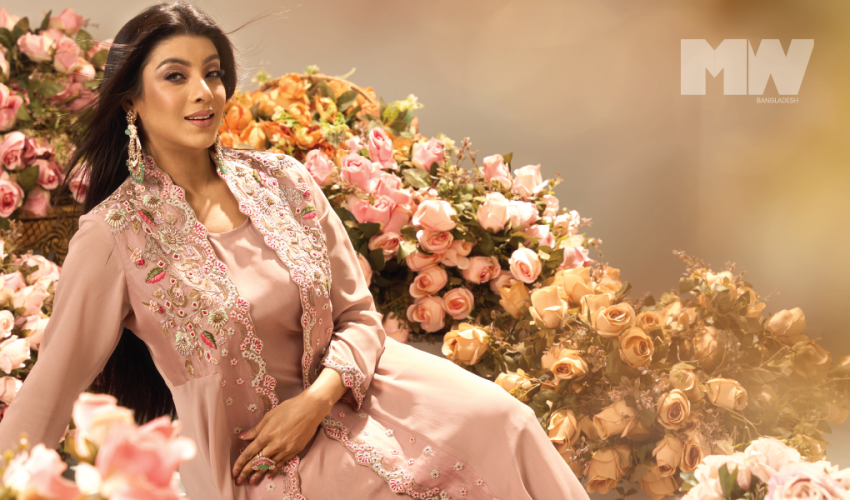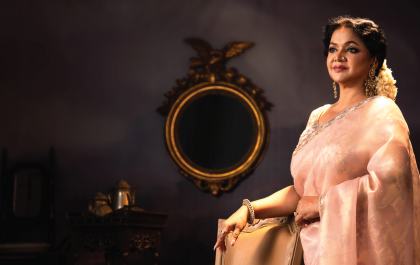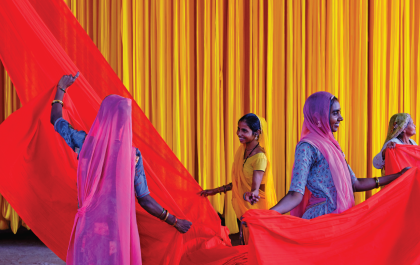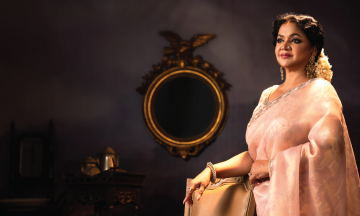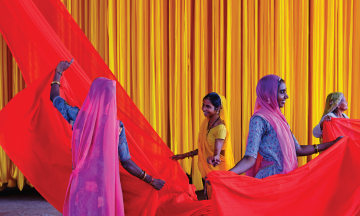By Anika Chowdhury
Sadia Islam Mou – a name synonymous with grace, versatility, and resilience – has been in the cultural consciousness for over three decades now. Born into a liberal and culturally rich family in 1976, Mou’s early life was steeped in artistic influence. Surrounded by the love and support of her parents and four sisters, she grew up in an environment where creativity and artistic expression were not just encouraged but celebrated.
From a young age, Mou was introduced to the world of dance, acting, reciting, and singing, following her mother’s dream for her daughters to carve out their own careers in the arts. This early exposure to diverse artistic disciplines not only honed Mou’s talents but also imbued in her a deep respect for art, a trait she attributes to her father’s honest and passionate approach to singing.
Though we know Mou to be an icon in the modelling industry, there is much more to her repertoire of work and achievements that underscores her status as an idol in Bangladesh’s cultural landscape. Starting with an advertisement for Bounce Shampoo, Mou has graced numerous television dramas and telefilms with her performances, showcasing her acting range and depth. Her roles often explore complex characters and social themes, resonating with audiences and critics alike. Her work in Niruddesh as a director highlights her behind-the-camera skills, but her acting in projects such as Guum and Uro Chiti demonstrate her on-screen prowess, contributing significantly to the narrative and emotional depth of these works.
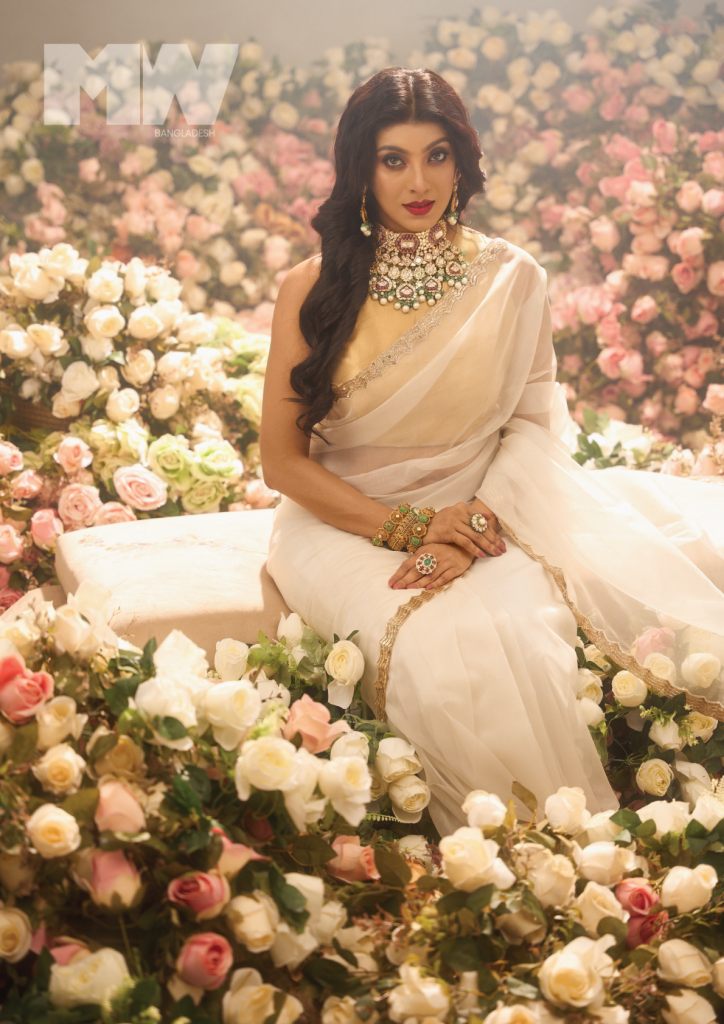
Beyond her on-screen roles, Mou’s contributions to dance cannot be overstated. Her performances and choreography in traditional and contemporary dance have been celebrated for their innovation and technical excellence. Mou has been instrumental in promoting dance as a form of artistic expression in Bangladesh, working to preserve traditional forms while also exploring modern interpretations.
Seen as a trend-setter and participating in countless fashion shows and campaigns, Mou has been a timeless figure when it comes to beauty and elegance. Her work has not only set standards in the fashion industry but also inspired new generations of models. Mou’s influence extends beyond the runway; she has been a muse for designers and a pivotal figure in promoting fashion as an integral part of Bangladesh’s cultural identity.
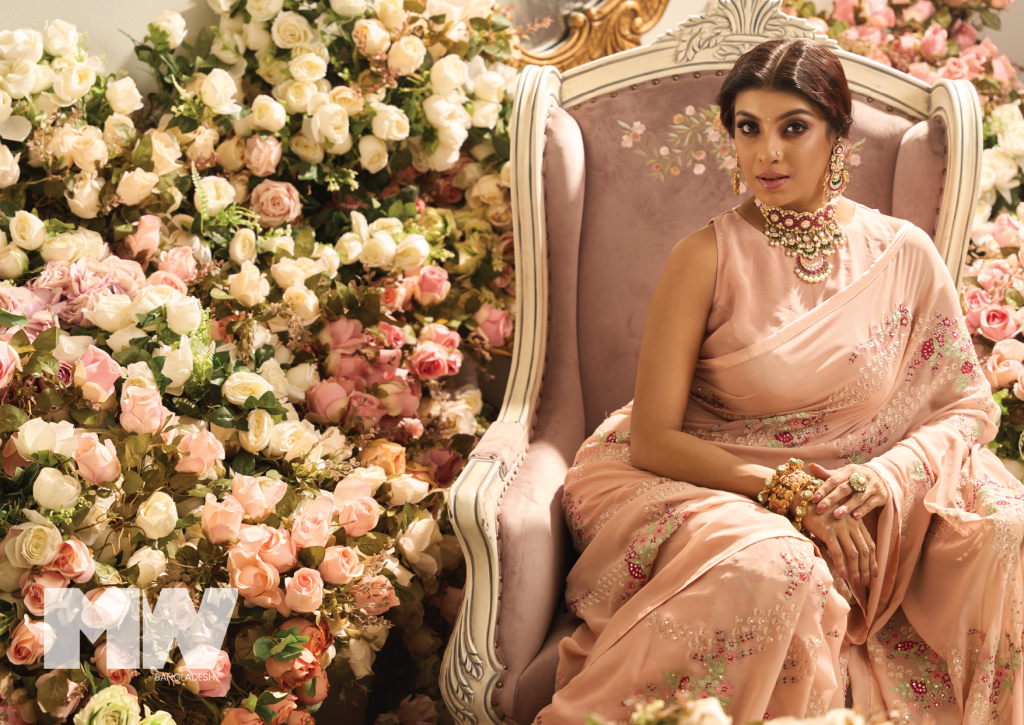
Mou has built a personal brand that embodies professionalism, creativity, and integrity. Prominent names such as Bibi Russell, Suborna Mustafa, and Afzal Hossain have called her the epitome of grace and professionalism. Her influence extends beyond her artistic endeavours, impacting fashion, lifestyle, and social norms in Bangladesh. Her ability to connect with diverse audiences and her status as a role model underscores the breadth of her impact.
MWB recently had the privilege of sitting down with the multifaceted and immensely talented Sadia Islam Mou, delving deep into her future plans, upcoming ventures, and aspirations that fuel her enduring journey in the entertainment industry.
Could you share with us a little bit about your childhood? What were you like as a kid?
My family has been very liberal and cultural right from the beginning. I am grateful to have grown up in such a family where I was surrounded by the love and support of my parents and four sisters. My mother dreamed that my sister and I should have careers of our own. Whether it was dancing, acting, reciting, or singing, my mother wanted us to be involved because she herself has been an artist.
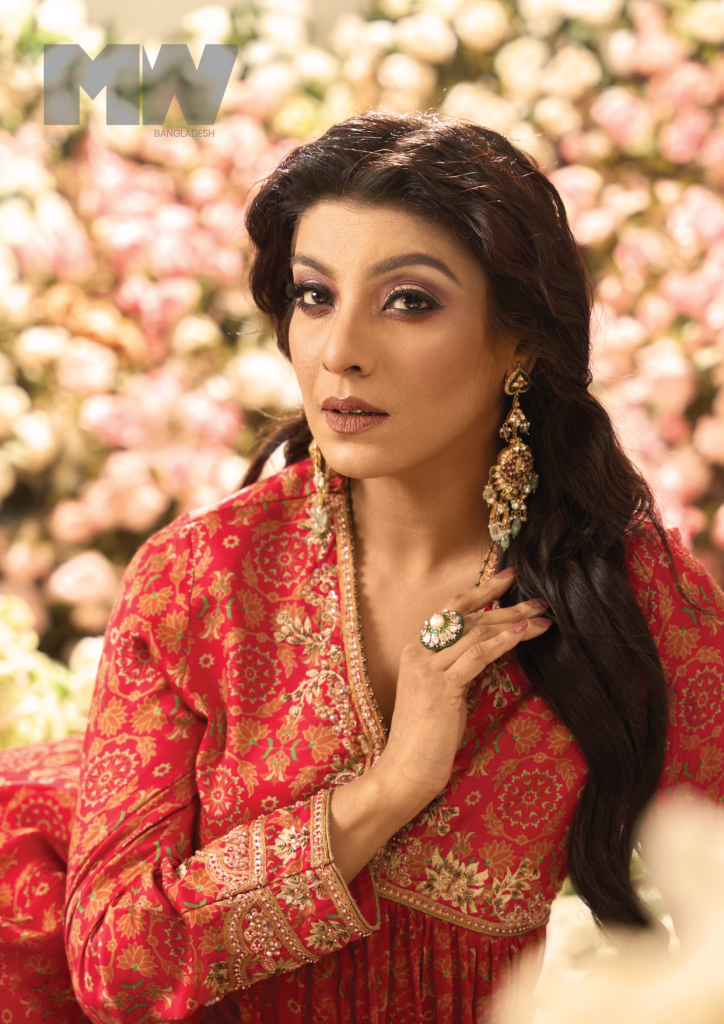
My father Saiful Islam was a reputed singer. I believe he was a true artist and a very honest person. Nowadays, we want to buy everything with money, including art. Nonetheless, my father never sang in exchange for money, he sang only because he loved singing. I believe every artist, who genuinely respects and loves his or her art, should do this. On Fridays, we used to wake up hearing the sargam practice of our father. He adored Hemant Kumar; now and then, we heard our father humming Hemant’s songs.
Presently, if electricity goes out, thanks to modern technology, you will not find any darkness. But back then, we didn’t have it and I do not regret not having those technologies because I had my father – he used to bring out his harmonium and started signing and being mesmerized we would gather around him and listen to his songs.
Another fondest memory I remember is the stories my father used to tell. Both my parents had been excellent story-tellers and they knew how an activity enjoyable. When the lights went out, my father scared and thrilled us with his ghost stories. We enjoyed them a lot. I feel like my childhood was the best time of my life and honestly, I didn’t understand it was so beautifully peaceful. I miss those memories.
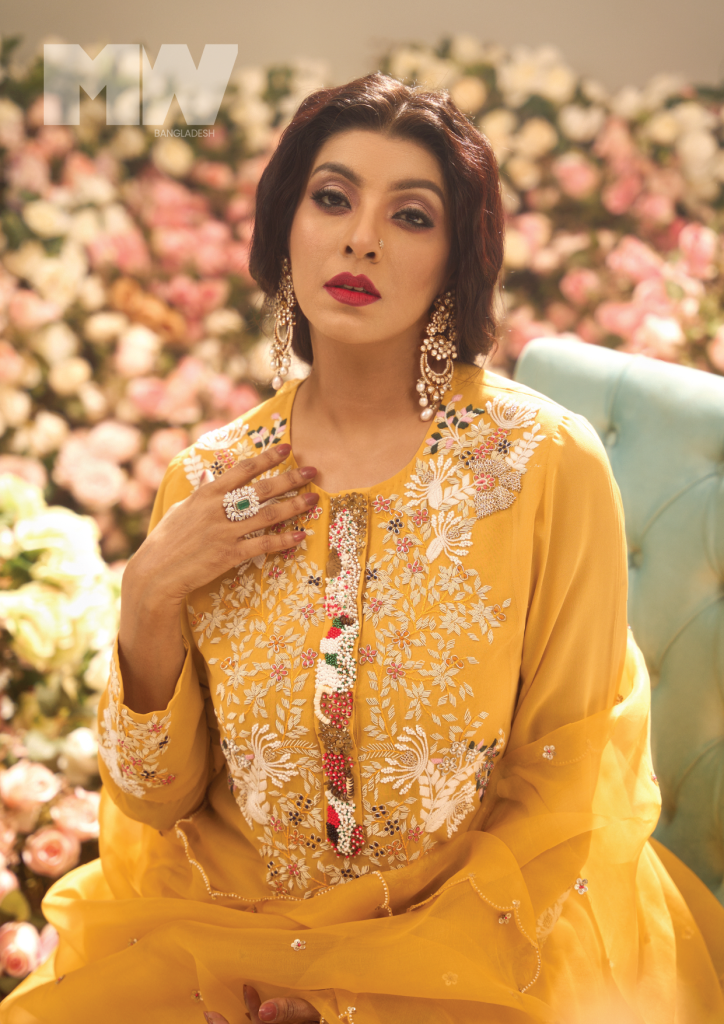
I try my hardest to impart the values and teachings to my children. But practically speaking, it is not possible. Our childhood had been starkly dissimilar from the present generation. I was born in 1976 and everything about that time was different. I can still vividly remember what I used to do during the 80s. We always ate dinner together – what if we fought? It didn’t matter, what if we wanted to eat outside? It also didn’t matter! – it was the rule of my mother and we followed it rigorously. Nowadays, I hear people making different excuses and skipping dinner, even though there is food in the home. We never had the chance to do this.
I want my children to have same the practice, but at a certain time, it is not possible. They are growing up in a new era and it is nothing like our generation. Still, they respect me a lot and try to follow this routine.
Nevertheless, I would say Covid-19 has changed our lives completely. For example, before the pandemic, my children went to bed at 7:30 PM. But during the lockdown, every time I would tell them to go to sleep, my children especially my son would contradict me, saying “Why would I sleep early? I don’t have school tomorrow!” So, I had nothing to say in reply.
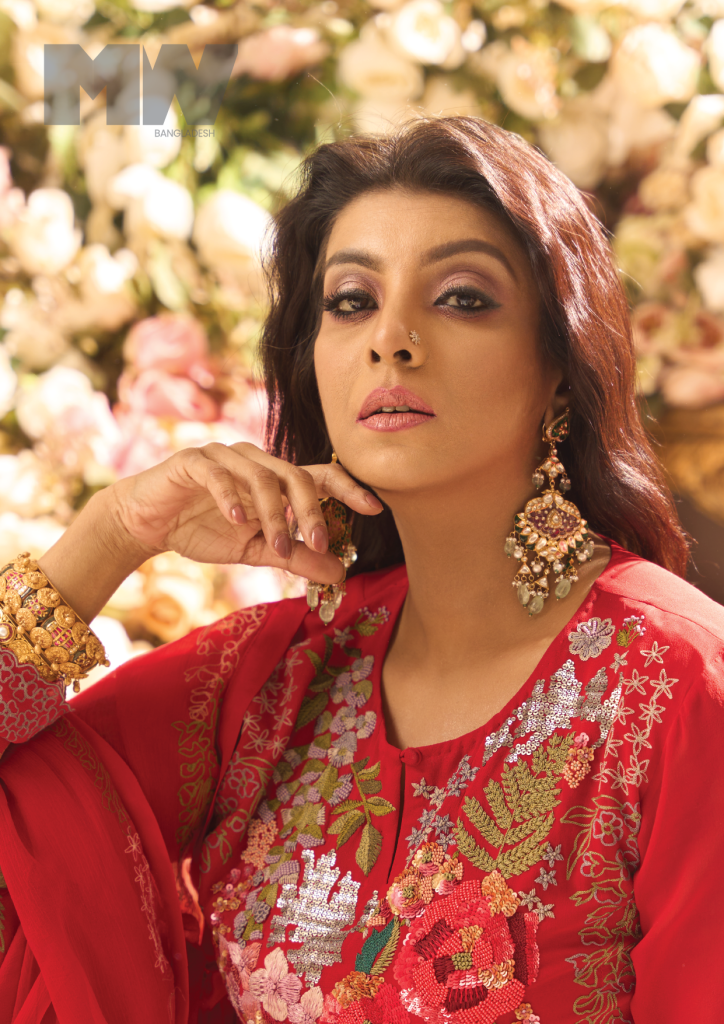
Children nowadays say what they will do after going home. But I was never like that because our house remained vibrant with my uncles, cousins, and aunts. I loved spending time with my grandparents – especially my grandfather. He was an exceptionally handsome man. So, boring was such a word we didn’t have in our dictionary.
Looking back, my childhood was a time of learning and growth, filled with joy, and laughter. It laid the foundation for the person I am today, instilling in me a love for discovery, a passion for creativity, and a deep appreciation for the connections that bind us.
Do your children, Pushpita and Zarif show any interest in the arts, be it dance, acting, or modelling?
Pushpita wants to be a businessperson. When she was young, my mother got her admitted into dance school, but she was quite reluctant about it. Consequently, she became busy with her studies and didn’t pursue dancing after the ninth grade. Though she has not shown that much of an interest in arts like her parents, Pushpita and I performed together and it was quite memorable. Pushpita is very studious and she admires her parents’ professions wholeheartedly.
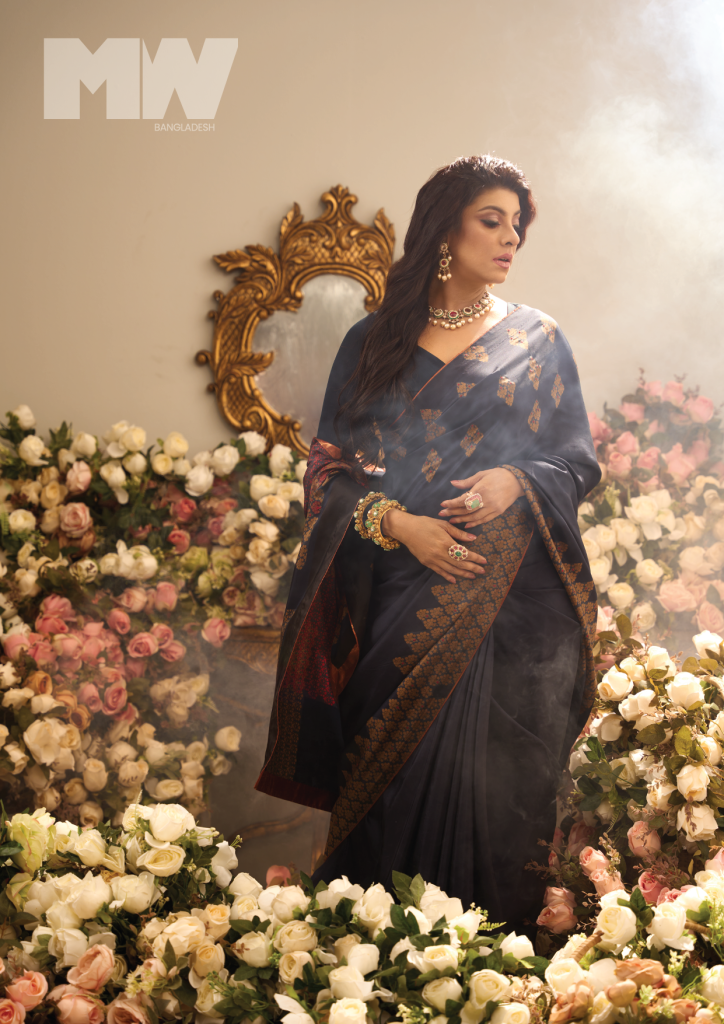
However, Zarif wants to become a model. He was mostly interested in sports. However, one day he came to me and said he was interested in modelling. And honestly, I was quite shocked to hear this. Nevertheless, I’m happy that he has shown interest in my field.
You began modelling for TVCs when the media industry was very small. There has been tremendous growth since. What, in your opinion and experience as an artiste, are some significant changes that have occurred in the evolution of advertising in this country?
During our time, modelling was a very niche industry and only a selected few would get the chance to this industry. Mostly, the girls, especially those who were involved with dancing like me, ventured into modelling. Even most male models were either from Dhaka city or came into this industry after returning from abroad. Back then the industry was small and people rarely wanted to become models – especially in fashion shows. So, early in my career, the representation was limited, often reflecting a narrow slice of society.
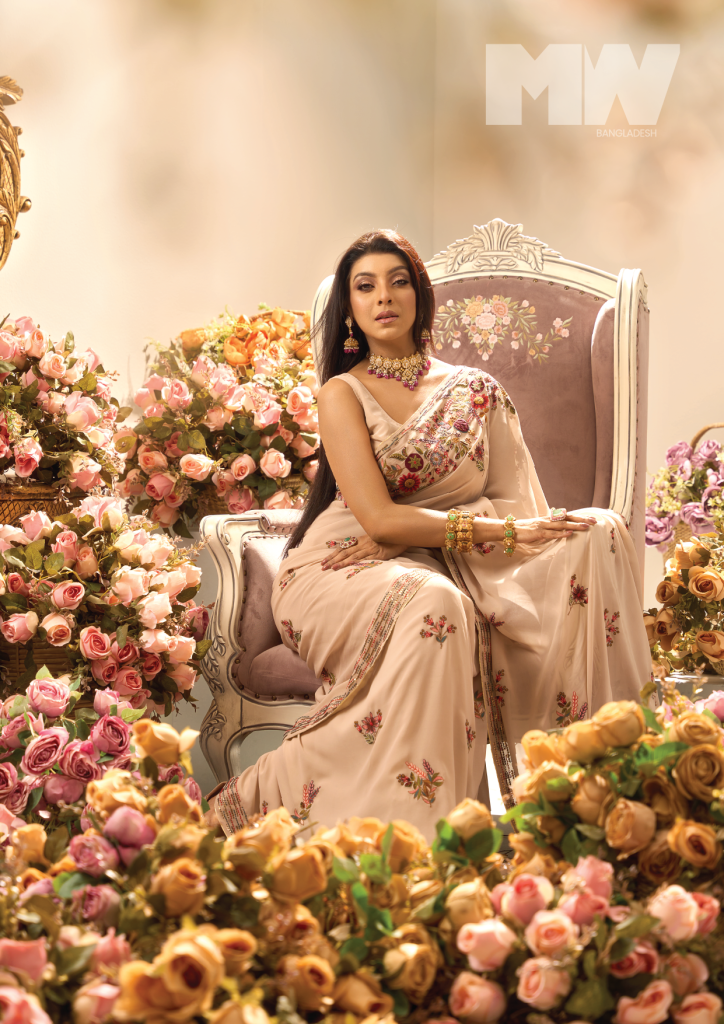
But I am happy to see that parents, especially mothers, want their children to become models. I have seen mothers who come with their children for dance classes telling me they admire my work and want their children to do the same. I am grateful for this shift in people’s mindsets.
Some mothers informed me that they teach their children to dance so that eventually they become actors or models. So, dance has nowadays become a medium as well. I truly get thrilled and honoured by the respect I receive from the younger generation. Whether it was for me or Noble, the 90s had been our time. Now it is time for the new generation to come forward and bring newness to the industry.
Back then, our advertisements were jingle-based. Modern advertising has moved beyond simply broadcasting a message to engaging consumers in a dialogue. The work we do now often extends beyond the ad itself, involving a continuous engagement with the audience through various digital channels.
Today, there’s a growing recognition of the importance of inclusivity, with ads more accurately representing the diverse fabric of our country. Back then, yellow journalism was quite prevalent. But fortunately, I don’t see this often. This change not only enriches the content but also resonates more deeply with a broader audience, creating a more inclusive and relatable advertising landscape.
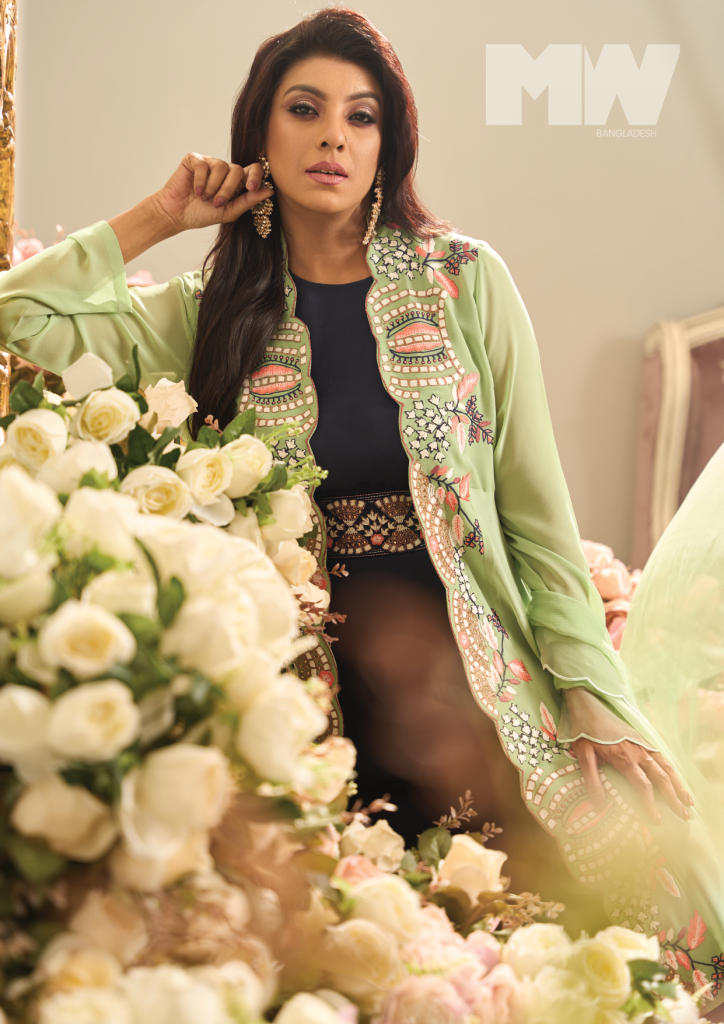
It is said that modelling is a demanding profession and models have short careers. And yet you’ve been reigning in this industry for three decades. What do you think contributed to such stunning longevity?
I believe not only modelling but every profession can be very demanding and requires our complete attention. Similar to modelling, dancing can be equally physically straining, it requires tonnes of mental stamina. You may say acting doesn’t require this. But when I got into acting, I realized how much brainwork and mental preparation it demands from us. Even ramp walks can be very challenging. My friends used to joke saying that they would have juice ready in case I fainted.
When you walk on the stage, all the eyes are set on you and you are the centre of attention. At times, it can be incredibly pressuring. You have to be very proper and strategic. But models indeed have a very short career. Presently, we have plenty of opportunities as we can teach and carry this profession forward.
When it comes to dancing, the scenario is very different. The careers of dancers start after they are in their 40s. A woman from India had been my dance teacher and she spoke using both Bangla and Urdu. I used to learn Odissi from her. They become teachers after learning to dance for a very long time. And they get to have a very long and fulfilling career.
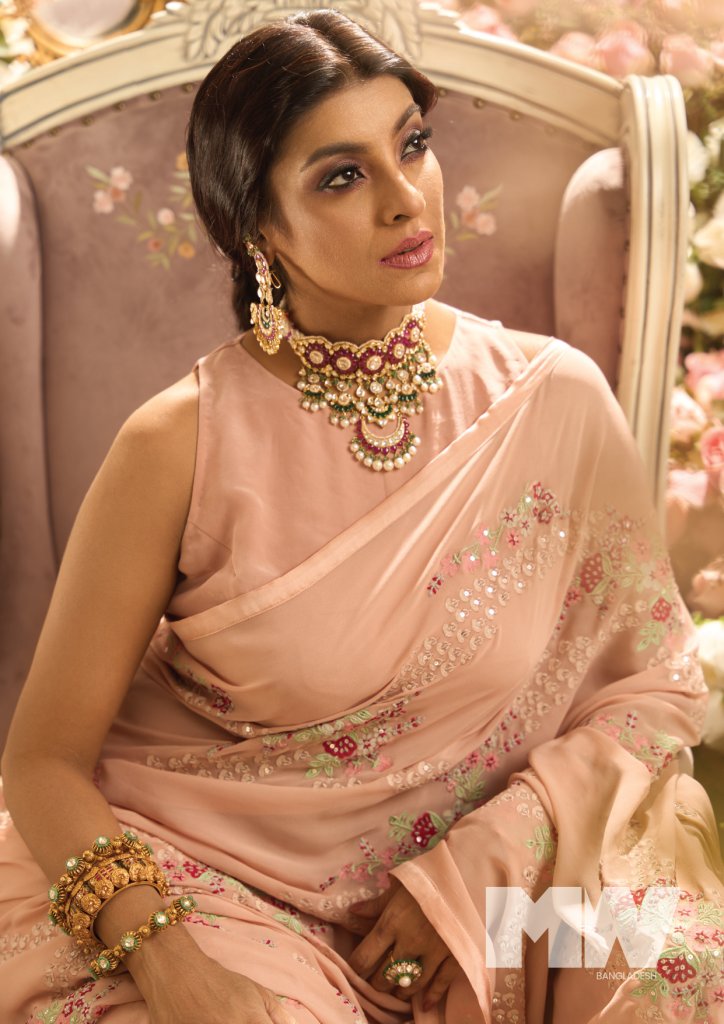
But when it comes to us, we get married and have children after a certain period and after that, our career is doomed. However, I have been inspired by my daughter, Pushpita to return to the limelight. I wasn’t in shape after such a long break and didn’t want to work. But my children were insistent and they motivated me to come back to work. They have been my biggest support system and perhaps this is the reason I am working now.
But above all, it was my children, Zarif and Pushpita who have been my biggest cheerleaders. I am incredibly grateful to my family for the support they have offered me.
It is impossible to write about Sadia Islam Mou and not mention your incredible beauty. What, in your opinion, makes a person beautiful?
Beauty, in its essence, transcends the superficial layers that meet the eye. Someone’s behaviour and etiquette make them appear beautiful to me. It is not the person’s skin tone or physique, but rather his or her tone, cordiality and honesty that make them appear attractive. While I find one person beautiful because of their behaviour, another ugly because of their behaviour and attitude.
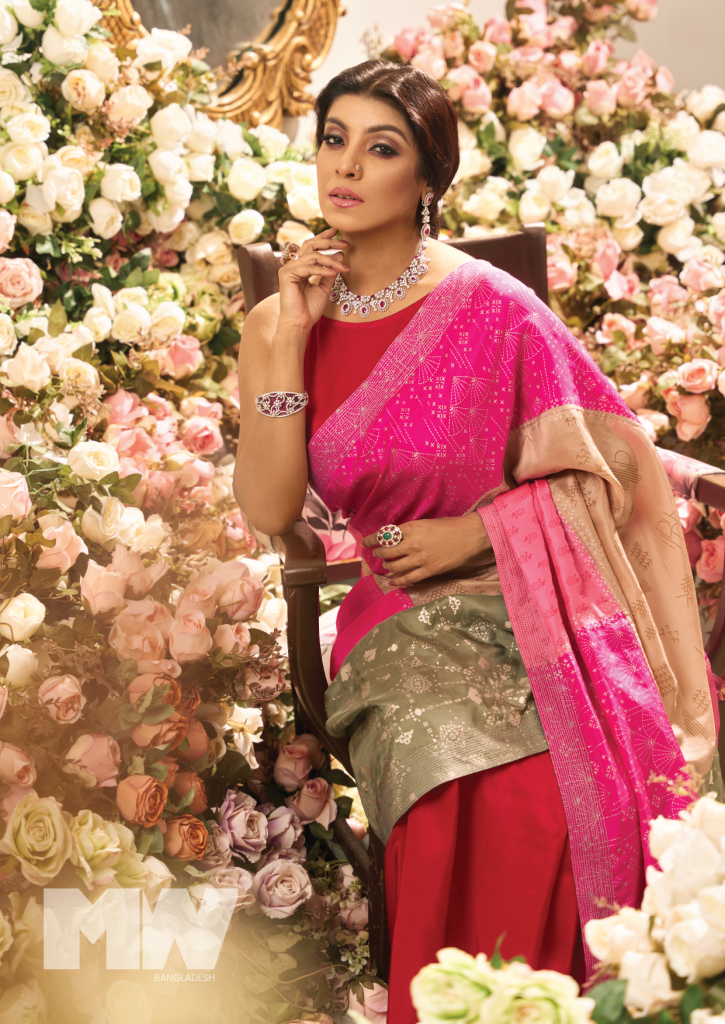
Yes, from a distance a person – whether it is a male or female – may appear attractive to me due to their clothes, make-up etc., However, after talking to them if I don’t find their behaviour appealing, then it is a huge turn-off for me. I even constantly lecture my children about the importance of behaviour and etiquette. Similarly, each of my family members has always behaved sweetly and cordially – it has been the teaching of my parents – and perhaps, this is why we have continued this tradition.
In essence, beauty is a multi-dimensional concept that defies standard definitions. It’s not just about symmetry, proportions, clothes, or physical attributes but about the intangible qualities that an individual embodies. The true measure of beauty lies in the impact one has on the world and the people around them.
Your first telefilm was Ovimane Onuvobe (1995), and you have been known to be very selective about your projects. Can you tell us what you look for in a role?
At one point, I was offered numerous roles in films, including from my uncle. However, during my time, meaning the 80s, there weren’t good films being made. So, it is not like I am very selective or choosy, I just didn’t find the perfect role for me.
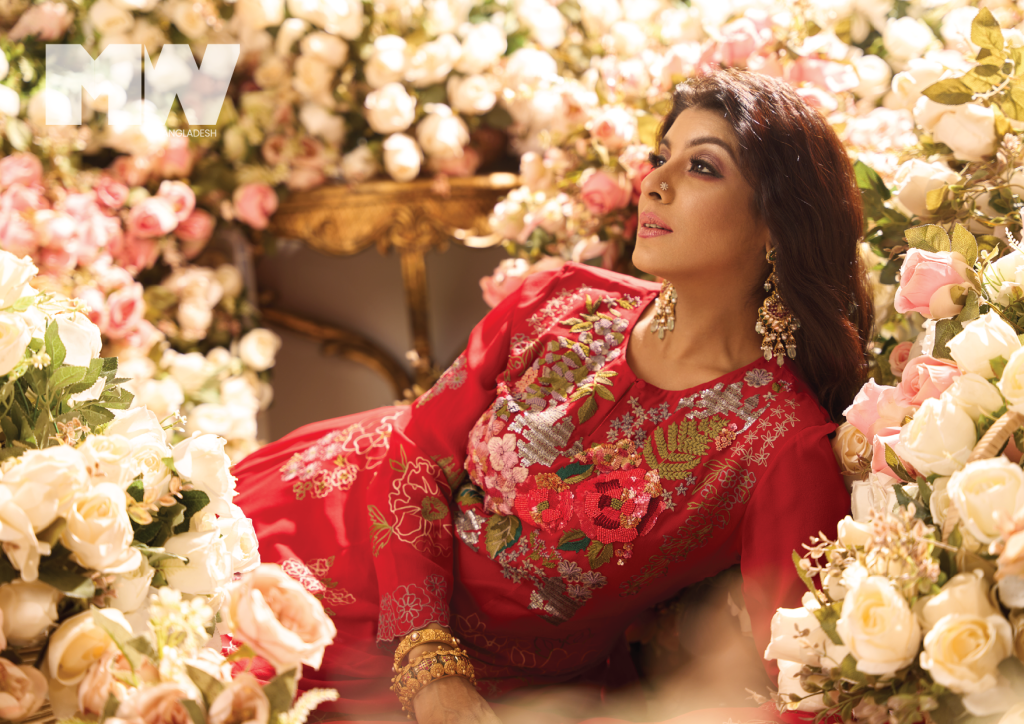
Presently, many good films are being made and everyone is going to cinema halls, including me. So, I wish that such good projects were in the making back then and maybe then I would have done more films or shows.
If I am offered a role in a film, I would first check if the narrative or plot of the movie requires my role or not and how important the role is essentially. I would play such a role around which the plot of the film revolves. If the plot doesn’t require my role, I don’t think going to get inclined in such a film.
In 2010, you decided to direct a special TV play Niruddesh. What made you decide to step behind the camera?
I actually wanted to work as a set designer. I noticed that the telefilms or dramas were shot in the same setting. So, I wanted to bring diversity and a different flavour. Typically, in our contemporary dramas, a poor house means a small hut with and broken roof or a rich house means an aristocratic house with a man smoking a pipe. I don’t think this should be the case. You need proper props and other elements that would go with the story. Besides, I have always loved decorating my own house and keeping it neat. In that vein, I wanted to take charge over the visuals. But never once I thought I would step behind the camera. It happened quite organically.
The cameraman Anam Hossen Bulu and the respected artists Humayun Faridi and Zahid Hasan helped me direct Niruddesh. They had been incredibly supportive; otherwise how could I direct such brilliant actors? It was something that I had never imagined.
I have given directions to dance and song performances before. I remember I performed in a singing show at ATN Bangla and many well-known artists were there. I directed it differently, not the way people used to do in those days.
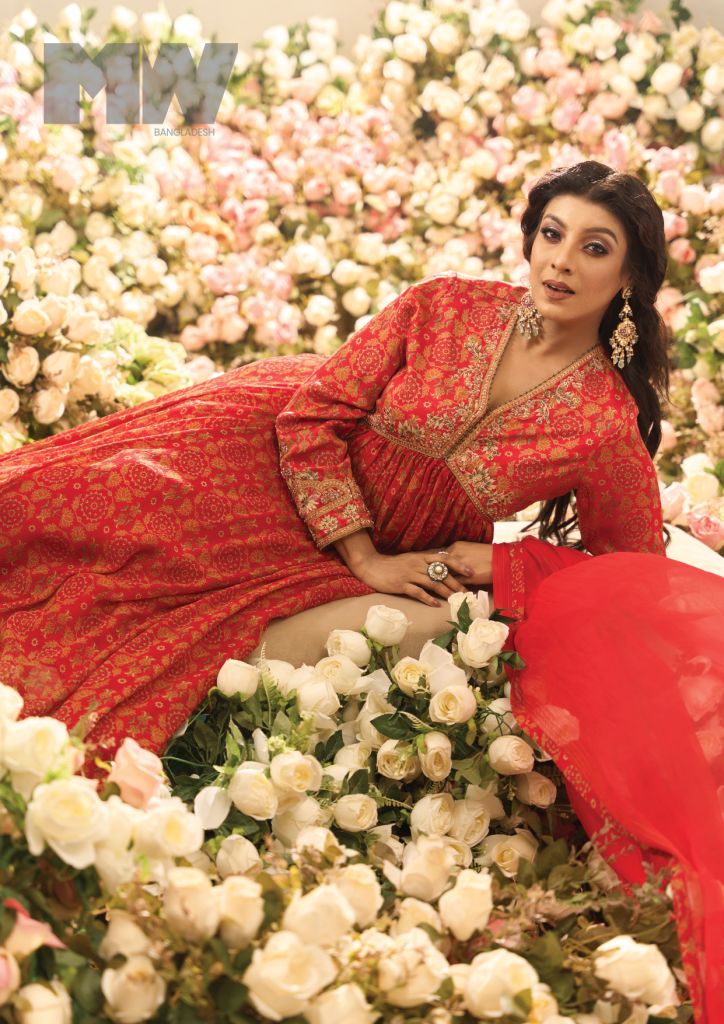
Throughout your career, you’ve also been involved in teaching and mentoring young dancers. What do you believe is essential for a young dancer to learn in today’s world?
I think the young dancers nowadays are doing an excellent job. We see a lot of modern and contemporary dance styles and they are definitely not easy. Even though I was not properly aware of this, my daughter Pushpita told me about it. So, I think they are doing just fine. However, I would suggest they try to nurture patience. It is an essential life skill that can help anyone go a long way.
Every artist has their muses and sources of inspiration. What are yours?
My family. They are everything. They inspire me, motivate me and help me to keep moving forward.
Recently, you worked with trans people on a fashion show. What motivated you to work on this project?
I have worked with trans people numerous times before. I have given direction to their dance performances and whenever I am invited to such projects, I always try to go there. Even from my early days as a dancer, I have known many trans people. Never once I have felt any prejudice towards them, rather I felt connected to them as a human being.
My colleagues from my community often bring such proposals. So, the idea of a fashion show came through an NGO as well. For me, collaborating with trans people on different projects means an opportunity to learn from their experiences, listen to their stories, and understand the challenges they face.
Your film Nari tackles critical issues like child marriage, acid attacks, and rape incidents. What was the initial spark that led you to work on this film?
I played the role of a corporate professional who accidently got pregnant. But due to societal pressure, she had to abort the baby and it broke her. I loved the script and the characterization was the first thing that drew me to her.
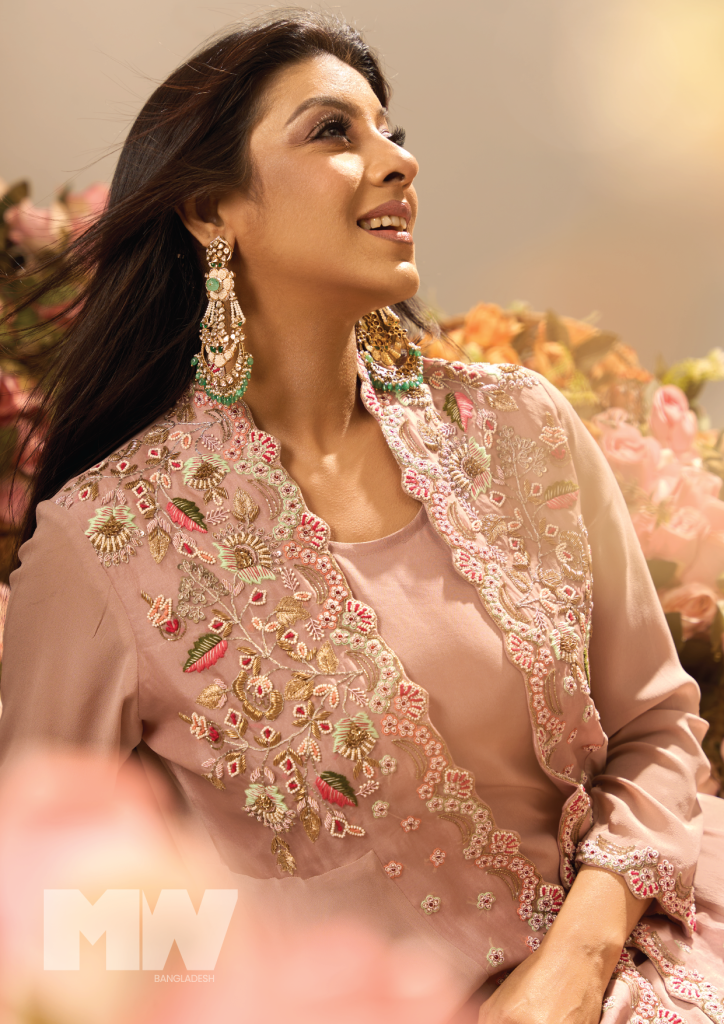
As someone who has successfully navigated multiple facets of the entertainment industry, how do you see your artistic identity evolving in the next few years? Are there new genres or mediums you’re eager to explore?
As for upcoming projects, if I am offered any good projects or roles, I would definitely do it. Looking ahead, I see my artistic journey continuing to unfold in unexpected and exciting directions, driven by a curiosity to explore new genres, mediums, and collaborative opportunities.
Beyond everything, my deepest desire echoes the soul-stirring melody of my father’s beloved song, “Tumi Shondha Akasher Tarar Moto Amar Mone Jolbe.” Just as those timeless notes linger in the air, weaving into the fabric of our memories, I want to etch a place in the hearts of my audience, to remain alive in their spirits – like an ever-glowing star in the sky.




